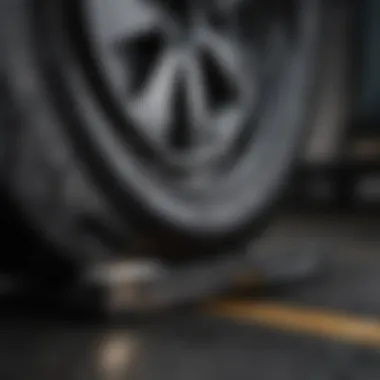The Importance of Checking Tire Tread Wear for Safety


Intro
Assessing tire tread wear is a fundamental component of vehicular maintenance that directly impacts safety and performance. The tread of a tire serves multiple purposes, primarily providing the necessary grip on the road. When the tread wears down, it compromises traction, particularly in adverse weather conditions, leading to a higher likelihood of accidents. Many vehicle owners may tend to overlook this aspect, often considering it a trivial task. However, understanding the importance of assessing tread wear can not only enhance the driving experience but also influence critical factors like insurance coverage and vehicle value.
Regular checks of tire tread depth can be both simple and pivotal. There are various methods to measure tread depth, including the classic penny test or tire tread depth gauges. Utilizing these techniques ensures that owners are aware of their tire condition, helping to preemptively address issues before they escalate.
In the following sections, we will delve deeper into various aspects related to tire tread wear, including its implications on insurance policies. Furthermore, we will explore how the assessment of tire condition can influence coverage options and risk evaluations when it comes to insuring a vehicle. In essence, this discourse not only caters to the safety of the driver but also extends to their financial planning regarding insurance.
Intro to Tire Tread Wear
Understanding tire tread wear is fundamental for both safety and performance of any vehicle. Regularly monitoring your tires allows you to catch potential problems before they escalate, ensuring a safer driving experience. The tread of a tire provides essential grip, affecting not only how your vehicle performs on different surfaces but also how well it handles potential hazards.
Tire composition is another key element to consider. Tires are made up of various materials that contribute to their performance and longevity. Knowing how these materials interact with the road can help you comprehend the implications of tread wear. Furthermore, the role of tread depth in vehicle safety cannot be overstated; tires with inadequate tread depth lose traction, especially in wet or slippery conditions, leading to increased stopping distances and compromised vehicle control.
In this section, we will explore two main aspects in detail:
Understanding Tire Composition
Tires are constructed from multiple materials, typically including rubber, fabric, and steel. The outer layer is primarily made from rubber, which offers flexibility and friction with the road. Beneath the rubber, layers of fabric, often nylon or polyester, provide the necessary strength and shape to withstand pressure and heat during driving.
The inner layer usually consists of a stout rubber that is resistant to air loss. This construction allows tires to support the vehicle's weight and maintain the required pressure. Importantly, these components also play a role in tread wear. For instance, high-performance tires may have softer rubber that can improve grip but wears out faster compared to standard all-season tires. Knowing your tire's composition aids in understanding its wear rate and longevity.
The Role of Tread in Vehicle Safety
Tread plays an integral role in braking performance, cornering stability, and overall traction. The patterns and depth of the tread affect how water is dispersed from beneath the tire, reducing the risk of hydroplaning. Tires with sufficient tread depth grip the road firmly, which is critical in adverse weather conditions, such as rain or snow. Studies have shown that tires with worn tread can increase stopping distances significantly, which can lead to dangerous situations.
Key points about tread wear impact on safety include:
- Reduced grip in wet conditions increases the likelihood of skids.
- Inadequate tread can lead to punctures or tire blowouts.
- Safe performance levels may not be achievable with worn tires, impacting driver confidence.
"Regular checks on tire tread can save lives and improve overall driving experience."
In summary, understanding tire tread wear is crucial not only for maintaining your vehicle's performance but also for ensuring safety on the road. Tire composition and tread are interrelated elements that every vehicle owner should prioritize in their maintenance routine.
Why Checking Tread Wear is Essential
Tire tread wear plays a crucial role in vehicle safety, performance, and even fuel efficiency. Regularly checking the condition of your tires is not merely a recommendation; it is a necessity. Failing to do so can lead to severe consequences that impact not only driving safety but also the overall performance of the vehicle.
Safety Implications of Worn Tires
Worn tires significantly increase the risk of accidents. Tread depth is directly tied to how well tires grip the road. When tread is reduced, the ability of tires to channel water away diminishes, leading to a higher likelihood of hydroplaning on wet roads. This compromise can have dire consequences for drivers, passengers, and other road users. Studies have shown that tires with insufficient tread depth greatly increase stopping distances, particularly in emergency situations.
In addition, a lack of proper tread creates challenges during cornering and braking. On worn tires, the vehicle can skid or lose control easily. Consequently, for any vehicle owner, ensuring adequate tread depth is a matter of personal safety as well as the safety of others.
Performance and Handling Considerations
Tire wear is intricately linked to a vehicle’s overall performance. When tread depth is low, the vehicle struggles with responsive handling. Drivers may notice that the car does not respond predictably to steering inputs and may even exhibit sensations of drifting. This affects not just comfort while driving but also makes everyday maneuvers more difficult.


Furthermore, worn tires can lead to uneven wear patterns that can cause additional problems for suspension systems and alignment. Over time, a vehicle may incur more considerable costs due to the extra wear and tear on associated components if tire maintenance is neglected. Therefore, attentiveness to tread wear is essential for preserving both the driving experience and vehicle longevity.
Effects on Fuel Efficiency
Tire tread impacts fuel efficiency in more ways than one might expect. When tires are worn or incorrectly inflated, they create higher rolling resistance, which demands more energy from the engine. Consequently, this can lead to increased fuel consumption, meaning more frequent stops at the gas station and heightened expenditure over time.
According to various sources, adequately maintained tires can enhance fuel efficiency by 3% to 4%. This may not seem like a significant amount, but when applied over the lifespan of the vehicle, it adds appreciable savings.
Regular tire maintenance contributes not only to safety but can keep fuel costs low and performance optimal.
Methods for Measuring Tire Tread Depth
Determining the tread depth of your tires is crucial. Proper tread depth influences vehicle safety and performance. Measuring tread depth consistently can alert you to when tires are approaching the end of their useful life. Regular checks also help prevent accidents caused by poor traction. Let's look at some methods for measuring tire tread depth that provide effective and reliable assessments.
Using a Tread Depth Gauge
A tread depth gauge is a handy tool for any car owner. This small device measures the depth of the tire tread accurately. Most gauges are easy to use; simply press the probe into the tire groove and read the measurement. Some models even feature a digital display, making it easier to see results at a glance.
Using a tread depth gauge regularly can help you establish a clear schedule for tire replacement. Ideally, check the tread depth at least once a month and before long trips to ensure safety. Furthermore, keeping records of the readings can help you spot trends in tire wear. This is valuable data should any issues arise later.
Penny Test: A Quick Indication
The penny test is a straightforward method that anyone can perform. For this test, take a U.S. penny and insert it into the tire tread with Lincoln's head facing downward. If you can see the top of Lincoln's head, your tread is too worn, and it may be time to replace the tire. Although this method is not highly precise, it provides a quick visual check for drivers on the go.
This test is beneficial for those who may not have a gauge handy. It helps to quickly assess if replacement is necessary, especially in cases of emergency. Always remember that ongoing monitoring is essential, even when using this simple method.
Visual Inspection Techniques
Visual inspection is another effective approach to evaluating tire tread. This technique involves looking closely at various aspects of the tire condition. First, examine the tread surface and look for uneven wear, which can indicate alignment issues or problems with the suspension.
Additionally, check for bald spots, cuts, or foreign objects embedded in the tread. Observing these signs can help you identify if there are underlying issues necessary to address.
Another point to notice is tread wear indicators. Many tires have built-in indicators that show when the tread is too low. When these indicators are flush with the tread, it is time for replacement.
Consistent checking of tire tread depth not only extends the life of the tires but also enhances overall driving safety.
Signs of Tire Tread Wear
Recognizing signs of tire tread wear is essential for maintaining an optimal driving experience and ensuring safety. Tires are the only contact point between a vehicle and the road, and their condition significantly influences handling, braking, and overall vehicle performance. Understanding the signs of tire tread wear can help vehicle owners take timely actions to prevent accidents and costly repairs.
Uneven Wear Patterns
Uneven wear patterns on tires can indicate improper alignment or inflation. When tires wear unevenly, some areas of the tread may be significantly thinner than others. This can lead to reduced traction and increased likelihood of blowouts.
To identify uneven wear:
- Examine tire tread depth across the entire surface.
- Monitor the inner and outer edges of the tire. More wear on one side suggests alignment issues.
- Check for vibration while driving, which may indicate misalignment.
Regular inspections allow vehicle owners to address these issues early, maintaining safety and prolonging tire life.


Bald Spots and Their Implications
Bald spots on tires are areas where the tread has worn down to a dangerous level. This not only affects traction but also compromises vehicle control, especially in wet conditions. When a tire is bald, it has reduced ability to channel water away, increasing the risk of hydroplaning.
To evaluate for bald spots:
- Look for smooth areas on the tire surface where tread patterns are absent.
- Perform the penny test: insert a penny into the tread; if you can see the top of Lincoln's head, it’s time to replace the tire.
It is crucial to replace bald tires promptly to avoid accidents.
Indicators of Structural Issues
Structural issues can arise from hitting potholes or curbs, leading to tread wear symptoms that signal more severe problems. Indicators of structural issues may include:
- Bubbles or bulges on the sidewalls.
- Cracks or cuts in the rubber.
- Vibration or pulling to one side while driving.
If any of these are observed, a professional assessment is necessary. Addressing structural damage not only assures safety but also enhances performance.
"Tires are not just rubber circles; they are critical components that directly affect your safety on the road. Regular monitoring of tread wear signs equips you with the knowledge to act before it's too late."
In summary, keeping watch for uneven wear patterns, bald spots, and indicators of structural issues enables vehicle owners to safeguard their safety while driving. Taking proactive steps to address these signs promotes durability and optimal vehicle performance.
Impact of Tire Wear on Insurance Policies
Understanding the impact of tire wear on insurance policies is vital for vehicle owners. It goes beyond the mere function of tires to encompass safety, liability, and financial implications in the realm of auto insurance. Addressing tire tread wear can have a direct impact on claims made after accidents, as well as the general premiums drivers pay.
Understanding Liability in Case of Accidents
When accidents occur, the condition of tires often comes into play during investigations. If a vehicle with worn tires is involved in an accident, it may create questions regarding liability. Insurance companies will examine whether improper tire maintenance contributed to the incident. This aspect is critical because if the tires are found to be a deciding factor in an accident, the driver may face increased liability.
In situations where it is determined that tread depth did not meet safety standards, the insurance policy may not cover the full extent of damages. As a result, drivers could be held responsible for costs that would otherwise be covered under their policies. This outlines the importance of keeping tires in optimum condition to minimize personal liability during accidents.
How Tread Conditions Affect Premiums
Tire wear can indirectly affect insurance premiums. Generally, insurance companies assess risk based on various factors, including a vehicle's maintenance history. If frequent claims are made due to tire-related incidents, insurers may perceive higher risk associated with the vehicle owner. Consequently, this could lead to increased premiums.
In contrast, maintaining adequate tire tread can demonstrate responsible vehicle ownership. As a result, drivers who keep up with regular tire checks and replacement might benefit from lower premiums. This connection between tire condition and insurance costs emphasizes the need for proactive vehicle maintenance.
Disclosure Requirements for Vehicle Owners
Many insurance policies have specific disclosure requirements regarding vehicle condition, including tire wear. Vehicle owners are often required to inform their insurers about any condition that could potentially affect safety or risk. For instance, failing to disclose known issues with tire tread could lead to complications when filing claims.
Failure to abide by these requirements can have serious repercussions. If an accident occurs and it is later revealed that the tires were significantly worn without disclosure, the insurer might refuse to honor a claim. Thus, it is crucial for vehicle owners to understand their responsibilities in maintaining and disclosing information regarding tire condition.
"Regular maintenance not only ensures safety but also maintains a favorable relationship with insurance providers."
In summary, the intersection of tire wear and insurance policies reinforces the importance of routine maintenance. Vehicle owners must be aware of how their tire conditions can influence liability, premiums, and disclosure requirements to safeguard their financial interests and safety on the road. By prioritizing tire tread checks, drivers can enhance their safety and make prudent insurance choices.


Best Practices for Tire Maintenance
Tire maintenance is essential for ensuring a vehicle's safety, performance, and efficiency. Neglecting this aspect can lead to reduced handling capabilities, increased fuel consumption, and safety hazards on the road. This section discusses best practices for tire maintenance that every vehicle owner should implement. The goal is to provide a comprehensive understanding of how these practices contribute to tire longevity, optimal performance, and overall vehicle dependability.
Regular Rotation and Alignment
Regular rotation and alignment of tires are crucial for promoting even wear and extending their lifespan. Tires wear differently depending on their position on the vehicle. For instance, front tires usually bear more weight and experience different forces than rear ones.
- Rotation Frequency: It is advisable to rotate tires every 5,000 to 8,000 miles. This can vary based on driving habits and tire type.
- Alignment Checks: An alignment check should be done at least once a year or whenever the vehicle encounters a significant curb strike or pothole. Misalignment can lead to uneven tread wear, making regular checks essential. Proper alignment enhances steering stability and increases tire life.
Neglecting rotation and alignment can lead to premature tire wear. Maintaining these elements improves safety by ensuring optimal contact with the road.
Maintaining Proper Inflation Levels
Maintaining correct tire pressure is crucial for safety, fuel efficiency, and tire longevity. Under-inflated tires can increase rolling resistance, resulting in higher fuel consumption. Conversely, over-inflated tires wear out the center tread more quickly.
- Check Pressure Regularly: Tire pressure should be checked at least once a month. Using a reliable tire pressure gauge can help ensure accuracy.
- Follow Manufacturer's Guidelines: The recommended pressure level is typically found on a sticker inside the driver’s door frame or in the owner’s manual. Proper pressure optimizes the vehicle's performance and handling.
Keeping tires inflated to the right level not only enhances safety but also leads to better fuel efficiency and improved handling.
Appropriate Tire Replacement Timing
Knowing when to replace tires is key to maintaining optimal safety and performance. Tire tread depth is one indicator, but other factors also influence the need for replacement.
- Tread Depth Monitoring: A tread depth of 2/32 inches is generally considered the minimum for safe driving. If tires are at this level or lower, it is time to replace them.
- Age Considerations: Even tires with plenty of tread may need replacement after six to ten years, depending on the manufacturer's specifications. The rubber can degrade over time.
Appropriate timing for replacement ensures that tires can function as intended. Delaying replacement can lead to unsafe driving conditions, particularly in adverse weather.
Key Takeaway: Proper maintenance practices can dramatically boost tire lifespan and enhance driving safety.
By adopting these best practices, vehicle owners not only improve their safety but also ensure that their tires perform efficiently, offering a smoother and more reliable driving experience.
Finale: The Link Between Tread Maintenance and Insurance
Maintaining proper tire tread is not just a matter of vehicle performance; it directly impacts insurance considerations as well. Ensuring that tires have sufficient tread depth can significantly reduce the risks associated with driving. In turn, this aspect can influence insurance premiums and coverage options. Policyholders need to understand that insurers often assess the condition of tires and other vehicle components when calculating risk. Therefore, regular tire maintenance is not merely good practice but also a strategic financial decision.
Key Elements of Tread Maintenance
Proper tire maintenance includes regular inspections, timely replacements, and adherence to recommended tire pressure. By taking these proactive steps, vehicle owners can avoid worn-out tires, which pose safety threats and lead to potential insurance complications. Damaged or bald tires could cause accidents, leading to liability. This can raise the likelihood of claims, which may not only affect individual premiums but also the entire risk profile of the insurance company.
Benefits of Regular Checks
Regular checks on tire tread can help vehicle owners identify issues before they escalate. Common benefits include:
- Enhanced safety on the road
- Improved handling and fuel efficiency
- Potential cost savings on premiums through proactive risk management
- Reduced likelihood of accidents that may increase insurance costs
Understanding the direct relationship between tread depth and insurance goes beyond simply maintaining a vehicle. It’s about safeguarding oneself and being smart with financial commitments.
"Regular tire tread checks can prevent accidents and save on insurance costs. Proactive vehicle care pays off in the long run."
Summary of Key Points
In summarizing the relevance of checking tire tread wear, several key points emerge:
- Tire tread depth is crucial for overall vehicle safety and performance.
- Regular maintenance reduces accident risk and enhances fuel efficiency.
- Insurance implications may arise from the condition of the tires, influencing premiums and coverage terms.
- Proactive checks on tire tread can prevent increased insurance costs and improve road safety.
Encouragement for Proactive Vehicle Care
Vehicle owners should adopt a proactive approach regarding tire maintenance. Simple measures like periodic tread checks and timely rotations can yield significant benefits. Beyond ensuring safety, this diligence can also lead to reduced insurance costs. Maintaining tires not only extends their lifespan but also gives vehicle owners peace of mind on the road. Every time you drive, think about the importance of reliable tires.



